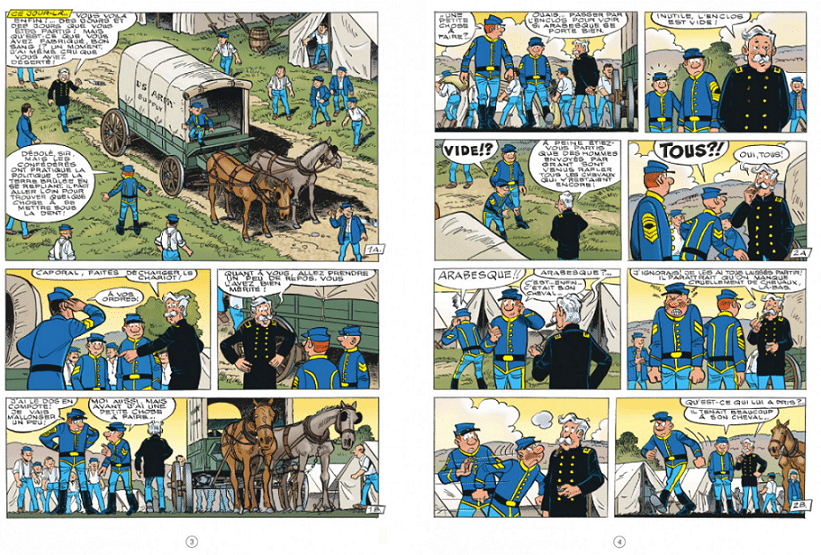Review of the ultimate Bluecoats #64 – Where is Arabesque ? by Raoul Cauvin
The 64th volume of Bluecoats, Where is Arabesque ?, is a small editorial event for those who are interested in traditional French-Belgian comics: it will be the last volume written by Raoul Cauvin, the creator of the series, after 50 years of service. Is it for all that an aesthetic event ?
Synopsis
Back from mission, Blutch discovers that Arabesque, his precious mare, able to play dead during the charges, has been requisitioned by another northern unit ! Drunk with rage, he destroys everything in his path, including the officers’ mess, but manages to convince Chesterfield to go and find his horse.
Review Bluecoats #64 – Where is Arabesque ?
Let’s start by saying that I am not a specialist of the series yet The Bluecoats. I read it according to the rhythm of what the libraries offered me, but never assiduously followed. I know well the universe and its dynamics, but I would be unable to say for example if there was a qualitative peak, when, with whom.
I don’t know, in the same sense, if the series has had a tendency to run out of steam over the length, even if I suppose it’s a fatality of serial works that last without marking the passage of time.

So to my initial question I answer no, this is not an aesthetic event – but nowhere does it seem that Cauvin and Lambil have tried to make it one. Where is Arabesque follows the usual specifications, both visually and narratively. The content of the story, on the other hand, does not indicate the desire to mark the occasion, but rather to act as if nothing had happened. Perhaps we can see a form of goodbye in this stroll very centered on the essential trio Blutch-Chesterfield-horse or in a last page almost tender, almost crepuscular.
But, to be honest, if I had read this volume without any context, I certainly wouldn’t have looked for and therefore not noticed this kind of goodbye.
If Where is Arabesque doesn’t want to be an exceptional album and isn’t one, we can’t say that it’s a bad album. I find there all my pleasure of the Bluecoats the fluidity of reading, the classic comedy of characters, the lightness of tone that does not forget to evoke the heaviness of history (here, for example, we recall the use of drugs to amplify courage or dodge battles). I also feel a lot of sympathy for Blutch in this adventure, as he fights against all odds to find his beloved mare, even though she is useless, or perhaps beloved precisely for that reason.
Without speech, Blutch’s vigor to save the unproductive, the living for the living, lets us once again glimpse Cauvin’s not at all warlike sensitivity.
Conclusion
An additional pleasure comes from finding the Blue coats unchanged in the current aesthetic context. The serial format invades everything, starting with the serial art forms. We think we’re augmenting serial forms by beefing them up with narrative threads, but this only empties them of their substance. No more chronicle, no more theme, no more contemplation: twists and turns and preparations for twists and turns.
We wish good luck to the owners of the Blue coats, since the merchants don’t know how to stop a series – we could see with the hundred other comic series kept alive artificially that the scenaristic balance of these old classic routines is quite fragile.